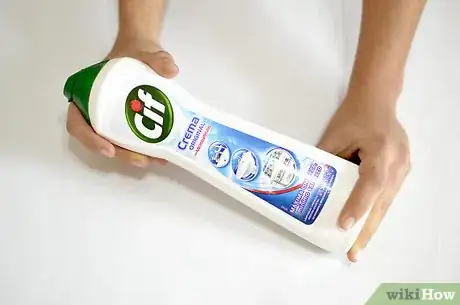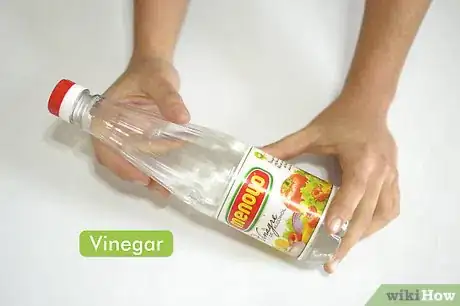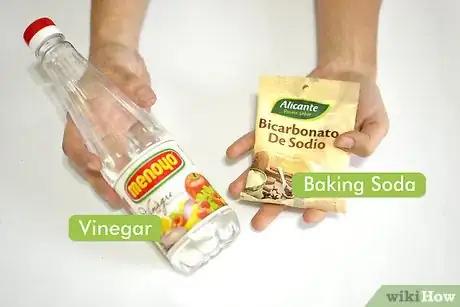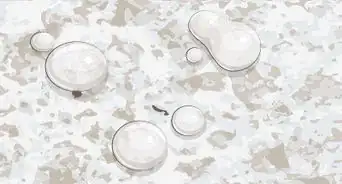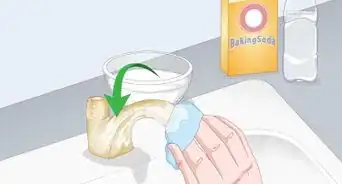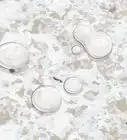This article was co-authored by Andrii Gurskyi. Andrii Gurskyi is the owner and founder of Rainbow Cleaning Service, a New York City cleaning company specializing in apartments, homes, and moving cleanup using non-toxic and artificial fragrance free cleaning solutions. Founded in 2010, Andrii and Rainbow Cleaning Service has served over 35,000 customers.
This article has been viewed 19,122 times.
Faucets get a lot of use and the very water that runs through them can cause corrosive buildup. A basic cleaning with a rag usually removes small smudges. For more serious mineral build-up, however, you will often need to use abrasive cleaners. If water flow has been compromised, you might need to take it apart the filter and clean it.
Steps
Performing Basic Maintenance
-
1Clean soft stains with water. You should be able to remove small smudges without any cleaning solution. Simply wiping the faucet down with a wet rag should be enough to remove most soft stains. Always blot the faucet dry after it gets wet.[1]
-
2Use a gentle cleaner to remove harder stains. For heavier stains, use a wet rag and a gentle cleaner to wipe down the faucet. Vinegar or all-purpose cleaners should work well.[2]
- For a natural cleaner, mix equal parts white vinegar and water and apply it to the faucet. Do not use vinegar on iron. If you are unsure if your fixture is made of iron, test it on a small portion and see if the metal is rubbed off.[3]
- Acceptable store bought cleaners include Formula 409, Windex, and Fantastik.
Advertisement -
3Use vinegar or bleach to disinfect. When your faucet has likely come into contact with germs and bacteria, you can use either bleach or vinegar to disinfect. Do not use a sponge to apply the solution, because sponges collect bacteria and germs rapidly.
- For vinegar mix equal parts white vinegar and water and use a clean rag to apply the solution. Vinegar is a safe, natural disinfectant that is kills most problematic bacteria.
- For a bleach solution, mix one tablespoon of bleach with a quart of water. Use gloves so that your skin does not come into contact directly with the bleach.
-
4Dry off excess water. When your facet is wet from use or cleaning, wipe it down with a dry rag to wipe off water. Blot water off gently.[4]
- If you don’t blot off water, minerals can accumulate, creating a build-up that can be hard to clean.
Removing Buildup
-
1Clean red or reddish brown deposits with lemon juice. Rust and iron need to be cleaned with acid scouring rubs. Try mixing lemon juice with borax to create a paste. Then use a rag to rub off the build up with the paste.
- Alternatively try mixing one part oxalic acid to ten parts water.
-
2Clean green deposits with ammonia. For green or bluish green deposits, mix equal parts water and ammonia. Use gloves and a rag to apply the mixture. After you finish, rinse the area well and flush out the pipes with water to remove excess ammonia.
-
3Clean black and brown build-up with cream of tartar. To clean darker build-up, mix cream of tartar with hydrogen peroxide to create a paste. Use a rag to rub it onto the faucet and remove build up.
-
4Clean soap scum with white vinegar. To pick up soap scum and particularly bad water marks, use white vinegar. Mix it with baking soda to create a paste. Apply it and let it sit. Then rinse it off and dry.
Improving Water Flow
-
1Wrap a towel around the filter and use a wrench to unscrew it. Most faucets have a small removable filter at the end. Wrap it in a towel so that it does not get scratched up. Then use a wrench to turn it counterclockwise and loosen it. Once it is loose, you can finish unscrewing it with your hand.[5]
-
2Disassemble the filter. There should be several components of the filter. Take it apart, observing how the parts fit together. You will need to remember how to put it back together before reinstalling it.[6]
-
3Scrub the filter with a toothbrush. Run the filter through warm water. Use a tooth brush to get in the hard to reach spots and remove build up.[7]
- Alternatively, you can put a pin through the holes in the filter to remove build-up in the small holes.
-
4Boil the filter in vinegar to remove calcium. Put white vinegar on the stove and heat it to a near boil. Let it sit for about an hour and then rinse it off after it cools.[8]
- This step should only be necessary if you see a red build-up on the faucet.
-
5Reinstall filter. Put the filter back together as it had been. Use your hand to turn it clockwise and tighten it. Then, use a rag and wrench to tighten it back up.[9]
Expert Q&A
Did you know you can get expert answers for this article?
Unlock expert answers by supporting wikiHow
-
QuestionHow do you remove mineral deposits from faucets?
 Andrii GurskyiAndrii Gurskyi is the owner and founder of Rainbow Cleaning Service, a New York City cleaning company specializing in apartments, homes, and moving cleanup using non-toxic and artificial fragrance free cleaning solutions. Founded in 2010, Andrii and Rainbow Cleaning Service has served over 35,000 customers.
Andrii GurskyiAndrii Gurskyi is the owner and founder of Rainbow Cleaning Service, a New York City cleaning company specializing in apartments, homes, and moving cleanup using non-toxic and artificial fragrance free cleaning solutions. Founded in 2010, Andrii and Rainbow Cleaning Service has served over 35,000 customers.
House Cleaning Professional Treat tough stains with a chlorine bleach solution. If vinegar isn't getting the job done, you can mix 1 part bleach with 3 parts water and then scrub at the stain with that solution just as you would with a vinegar one. Make sure to wear gloves and have eye protection since you are working with bleach.
Treat tough stains with a chlorine bleach solution. If vinegar isn't getting the job done, you can mix 1 part bleach with 3 parts water and then scrub at the stain with that solution just as you would with a vinegar one. Make sure to wear gloves and have eye protection since you are working with bleach.
References
- ↑ https://www.deltafaucet.com/design-innovation/inspiredliving/how-to-clean-a-faucet
- ↑ https://www.deltafaucet.com/design-innovation/inspiredliving/how-to-clean-a-faucet
- ↑ http://commonsensehome.com/how-to-remove-hard-water-buildup-from-faucets-and-showerheads/
- ↑ https://www.deltafaucet.com/design-innovation/inspiredliving/how-to-clean-a-faucet
- ↑ http://www.dummies.com/home-garden/plumbing/clogs/how-to-unclog-a-faucet-aerator/
- ↑ http://www.dummies.com/home-garden/plumbing/clogs/how-to-unclog-a-faucet-aerator/
- ↑ http://commonsensehome.com/how-to-remove-hard-water-buildup-from-faucets-and-showerheads/
- ↑ http://commonsensehome.com/how-to-remove-hard-water-buildup-from-faucets-and-showerheads/
- ↑ http://www.dummies.com/home-garden/plumbing/clogs/how-to-unclog-a-faucet-aerator/
